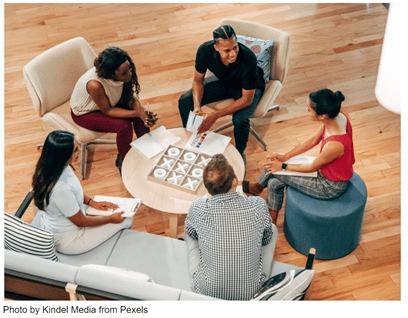
And What Employers Can Do About Burnout and Fatigue
The American workforce is exhausted, discouraged, anxious, and overwhelmed. It’s clear. Maybe you’re even feeling that way. And certainly, you know a handful of people who have expressed those emotions this fall.
Headline after headline captures those sentiments.
And yet…
Your people are still showing up.
Your people still care about their jobs and do their best.
And they continue to make a difference for those they serve.
But when more than 750,000 people die from COVID in your country in a year and a half, it’s going to impact your team; and their mental health.
Let’s take a look at how generational differences are impacting the workplace dynamic; along with a few strategies to reduce burnout and fatigue.
What are the generations that make up the workforce?
To understand the generational differences, it’s important to understand the language and terms that define the generations.
Baby Boomers usually refer to the post-World War II generation, born between 1946 and 1964. Generation-X, or Gen-X, represents people born between 1965 and 1980. Generation-Y, most often referred to as Millennials, we born between the years of 1981–1997. And anyone born between 1997 and 2012 is considered a member of Gen-Z.
And it’s important to respect all generations. No one generation makes a better worker than the other.
Each person, each employee you thought well enough of to hire is a gift to your organization. And is a critical component of your ability to meet your goals and mission. The more perspectives, experiences, and knowledge your team has, the better.
Generational differences when it comes to mental health in the workplace
People are isolated, stressed, and overwhelmed. The toxic nature of our individualistic culture has worn on individuals, impacted their relationships with friends, family, and coworkers, and led to a sense of going from one crisis to another.
Whether it’s human-inflicted, such as community violence, school shootings, and racism, or natural disasters and COVID, it seems that collectively we can’t catch a break.
And think about it. Generation Z has never known a time without a crisis. They were very young on 9/11, have always known about school shootings – and have always practiced drills in the same way previous generations had fire drills. It’s the generation that knows war (sometimes several at once), and the -isms (racism, sexism, ageism, to list a few). They are committed to their values, both at work and at home, more than any previous generation.
And managers and leaders, typically in the Boomer and Gen X generations, have different experiences and worldviews. For many workers in these generations, they were encouraged not to bring their personal life into the workplace.
Over the years, each generation has sought out more meaningful, impactful connections with their colleagues and better alignment of their work with their values.
Even in television and the movies, philosophies of the 1980s and 1990s were predominately chasing the dollar at all costs. Today, people want more of a work-life balance and a positive work environment.
What can employers do about burnout and fatigue?
As employers, we need to be mindful of our teams, their demands and constraints, and well-being. Each team member is a whole person, experiencing great joy and deep despair within our workspace and outside of it.
So, what are you doing to reduce burnout and fatigue? Here are some great first steps.
1. Start by holding space with each employee.
When was the last time you spoke with your employees—individually. Taken one step further, when have you asked a question within that conversation and simply listened. With no intention of fixing, explaining, or course-correcting? Or, if you have a large team, have you trained direct supervisors to have these types of conversations?
Make time for true connection and conversation. Create a culture of checking-in. It will have a direct impact on your organization’s culture.
According to a Workforce Institute survey, 32 percent of respondents claimed they yearned for better communication—both sooner and more transparently—from their employers, which is a primary regret for more than one-third of executive leaders.
Being able to hold space for each complete, vulnerable human on your team. With their challenges, unique worldviews, stressors, and busy calendar.
If you want your staff to feel connected, to you, your organization, and its mission, reach out and create positive engagement and opportunities.
2. Gather small groups for inclusive conversations.
Organizational growth and change can be slow. The statement “we’ve always done it that way” is great historical information. But it doesn’t have to define how your organization does things moving forward.
Being willing to adapt is essential. It was before the pandemic, and it’s even more so now.
As a leader, your job is to think several steps ahead. To think, if I do “x” then what is “y”, and then what might/will happen next. It’s your job to plan for the future, and during the past 20 months, to plan for an unknown and ever-changing future. To write those plans in pencil, and be willing to change frequently.
And you make better decisions when you involve others. Particularly the people who are actually doing the work.
So start by gathering small, informal groups of people. And ask questions. A few examples might be… How can we inject more connection into the workplace? How could we attract (or retain!) talented people? Are there ways we could be more flexible? Or what do you think would make you more efficient, effective, and invested in your job?
The point is, have more inclusive conversations with your team, implement the ideas that they give you, and you’ll see a shift in their engagement and confidence in the workplace.
3. Offer meaningful benefits and incentives.
Employees want to be seen and understood. And one way to do that is to offer meaningful benefits and incentives.
At Community Connections for Children, Inc., that looks like:
- Reduced hours one week a month, what CCC calls rotation weeks. For that week, team members work 30 hours instead of 40 hours, leaving a half-hour early Monday through Thursday and having Friday off.
- Trusting employees to be professional and to perform at a high level of excellence while working remotely.
- Generous paid time off (PTO).
- Regular and sincere encouragement from management staff to utilize their time off.
- A meaningful commitment to diversity, equity, and inclusion, and real, impactful systems change.
Recently, a friend shared with me her company offered a free night at the movies, gifting each team member movie passes they could share with their friends or family.
Your team will tell you what matters to them. Listen in the conversations you’re having, and look for opportunities to show your respect for your employees as people, outside of them just being a worker for your company.
Valuing Each Employee Within Your Organization
In The Surprising Power of Simply Asking Coworkers How They’re Doing, author Karyn Twaronite, global diversity and inclusiveness officer, suggested that “when people feel like they belong at work, they are more productive, motivated, engaged and 3.5 times more likely to contribute to their fullest potential.”
As leaders, we need to remember that when people leave our organization, it’s most likely that they did so because of the culture, management, and leaders. As hard as it may be to do, it’s essential that leaders self-reflect and evaluate the culture of their organization.
CCC has been successful because of our culture. The team is empowered, engaged, and self-motivated. And during COVID, they were both flexible and resilient.
It’s a culture of inclusion and respect. We regularly have meetings and check-ins to support and engage with one another. We celebrate birthdays, anniversaries, and various “holidays” such as Oreo day. And we receive regular feedback through a variety of formats, including anonymous surveys and work of month that, “CCC is the best place I’ve ever worked” and “when I started here I thought it was too good to be true, but it’s really an amazing group of people who really care about each other and those we serve.”
And if you are getting feedback from your team or those that are leaving, pay attention.
People who know they are valued, respected, appreciated, and fairly compensated are individuals who remain in their position. And they are part of a team that brings positivity to the customers and clients the organization serves.
Something we’ve seen first-hand. For the past ten years, an average of two people per year leave CCC to accept employment somewhere else. Statistics that are unheard of in the nonprofit industry, and something we’re incredibly proud of.
“Alone, we can do so little; together we can do so much.”
– Helen Keller
About Community Connections for Children, Inc.
Community Connections for Children, Inc. (CCC) is a nonprofit centered in the heart of Pennsylvania. They serve childcare providers and low-income families ‒ the ones that have been impacted the most by the pandemic.
For you and your business, CCC helps keep childcare options open for your employees ‒ saving missed work hours and lowering on-the-job stress levels. They work with early childhood education programs and home-based providers to improve the quality of care, ensuring that all children enter school ready to be successful.
CCC works with many local businesses’ HR departments to help their employees find childcare. They also encourage businesses to support the child care industry through the Educational Improvement Tax Credit, direct financial support, partnering with local Early Childhood Educators to contract for slots or expand their programs, and providing scholarships/ tuition assistance as part of their benefits package.
Christy Renjilian serves as its Executive Director.
To learn more, visit childcareconsultants.org.

